Test your water knowledge!
Winter Trivia: Salt Reduction
Question 1: Just one teaspoon of salt pollutes how many gallons of water?
A. 10 gallons; B. 5 gallons; C. 25 gallons; D. 50 gallons
Answer: One teaspoon of salt PERMANENTLY pollutes 5 gallons of water. There is no cost-effective way to remove it from our lakes and creeks. Use only the salt you need, or switch to sand or grit for traction.
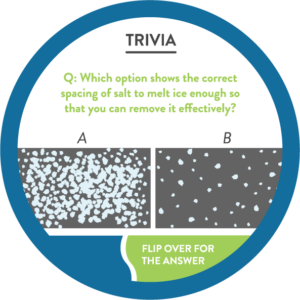
Question 2: How much salt is needed to melt ice from a 20-foot driveway, or 10 sidewalk squares?
A. 1 pound; B. 2 pounds; C. 5 pounds
Answer: 1 pound (enough to fill a 12 ounce coffee mug). Using more salt does not melt ice faster. Shovel first, then use just enough salt to un-stick the ice from the pavement, not to melt it away completely.
Question 3: In what order should you do these actions after a snowstorm: Scatter, Sweep, Shovel
Answer: SHOVEL (or snow blow) first, then SCATTER salt only if there is ice remaining. Lastly SWEEP up unused salt. It is not effective on dry pavement and pollutes our lakes and creeks.
Question 4 (see right): How much space should be left between each piece of salt when scattered?
Answer: Keep in mind that less is more when it comes to protecting lakes and creeks from pollution. Scatter salt in a way that leaves space between each piece. This gives enough melting power to effectively shovel or chip the snow and ice away.
More Salt Facts:
Nine Mile Creek has too much chloride in it. The chloride comes from salt used in the winter on roads, parking lots, and sidewalks. The amount of chloride in the creek make the water unhealthy for the aquatic animals living there.
Tips for Using Less Salt
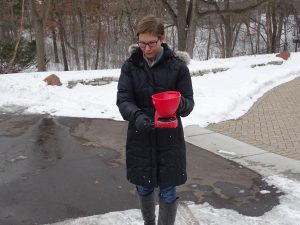 It is possible to reduce salt use while maintaining safe surfaces in the winter. Just follow these tips:
It is possible to reduce salt use while maintaining safe surfaces in the winter. Just follow these tips:
Shovel. Clear walkways before snow gets compacted or turns to ice. Apply salt only if needed.
Scatter. More salt does not mean more melting. Aim for 3 inches of space between salt granules. Use salt only where critical.
Switch. Common deicers don’t melt ice below below 15° Fahrenheit (pavement temperature), so should not be applied. Instead, use a small amount of sand for traction when it is too cold.
Sweep. Clean up leftover salt and sand on dry pavement, so it doesn’t wash into the creek. Reuse it as needed.
For more salt tips and resources, visit our salt reduction page: https://www.ninemilecreek.org/get-involved/learn/salt-reduction/
Summer Trivia: Lawncare
Irrigation
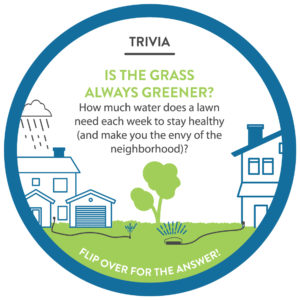
Problem: Even during or after a rainstorm, sprinkler systems are running. It is easy to set up an irrigation system and not think about it again. However, this usually leads to over watering your lawn. Not only does over watering waste limited fresh water, it also pollutes nearby water bodies. On average, a lawn only needs one inch of water every week during the summer to stay healthy and green.
Action: Changing your irrigation system is a straightforward solution to using less water (and saving money). Simply set your irrigation system to water less frequently and turn it off if it has rained recently, so your lawn isn’t getting too much water. You could also reuse water by purchasing and installing a rain barrel. A rain barrel collects rain from downspouts. You can then attach at hose at the bottom to water your garden, thereby conserving water.
Resources: For more information on water-saving tips for home lawns, visit:
extension.umn.edu/lawncare/water-saving-strategies-home-lawns
extension.umn.edu/lawncare/auditing-home-lawn-irrigation-systems
For more information on rain barrels, visit: recycleminnesota.org/work/compost-bins-rain-barrels/
Trivia Answer: A quarter-inch of water per week (minus any rainfall) is all that is needed to keep lawns alive during the summer.
Grass clippings
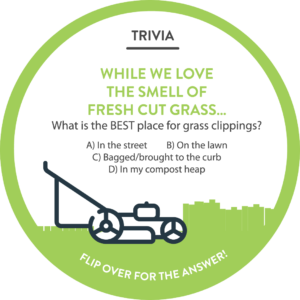
Problem: Leaving grass clippings on the street may seem harmless, but it is a large source of water pollution. Grass clippings left on the street will travel to the nearest body of water via storm drains. Grass clipping are particularly bad for lakes, because when they break down, they release nutrients like phosphorous and nitrogen. Too many nutrients in lakes fuels algae blooms.
Action: Grass clippings are best left on the lawn. Blowing or sweeping grass clippings back onto on your lawn will give nutrients back to your growing grass, keeping it healthier and greener. It also protects our lakes and creeks from becoming polluted.
Resources: For more mowing practices for healthy lawns, visit: extension.umn.edu/lawncare/mowing-practices-healthy-lawns
For more earth-friendly lawn care practices, visit: ninemilecreek.org/mow-high-sweep-clean/
Trivia Answer: Grass clippings add the equivalent of one fertilizer application to your lawn each year, the best place for them in on the lawn!
Storm Drains
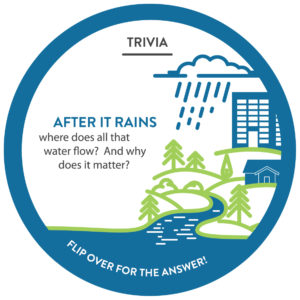
Problem: After a rain event, all the water runoff flows to the nearest storm drain. On its way to the drain, water will pick up anything in its path including grass clippings, fertilizer, dog droppings, leaves, and more. Unlike a water treatment plant, storm drains do not filter out any pollutants. Anything that travels with the water to a storm drain also travels to the nearest body of water. Stormwater runoff is one of the biggest sources of pollution to our lakes and creeks in urban areas.
Action: You can help keep pollution out of storm drains. Adopting a drain through the Adopt a Drain program is an excellent way to help keep our lakes and creeks clean. Adopting a drain involves selecting a storm drain near your home and pledging to keep it clear of leaves and debris. This simple act helps keep our waterways free of unnecessary pollutants. Remember to also sweep up grass clippings and clean up after your pets to keep our lakes and creeks clean.
Resources: To adopt a drain, visit: adopt-a-drain.org/
Trivia Answer: When it rains, the water flows off of of hard surfaces and picks up anything in its path including grass clippings, fertilizer, and dog droppings. It all flows to the nearest storm drain and into a nearby water body, polluting our lakes and creeks.
For more information on ways you can help keep the streets clean, visit: ninemilecreek.org/get-involved/how-can-i-help/
